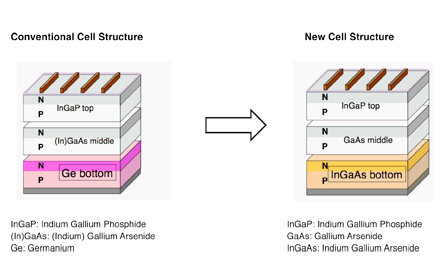Monday, October 26, 2009, 03:01 PM
Posted by Administrator
Posted by Administrator

Lets start by saying that all solar cells are not created equal. This is not a solar cell as mentioned in a previous article, this is a compound cell. This is much like stacking cells, but it is a lot more complicated. These are the kinds of cells used on satelites. The stacking or layering is the reason for the conversion being so high compared to the standard cells mentioned in the last article about solar efficiency record breaking.
Sharp achieves a new record using a triple-junction compound solar cell. See diagram above. To boost the efficiency of triple-junction compound solar cells, it is important to improve the crystallinity (the regularity of the atomic arrangement) in each photo-absorption layer (the top, middle, and bottom layer). It is also crucial that the solar cell be composed of materials that can maximize the effective use of solar energy.
Sharp has now succeeded in forming an InGaAs layer with high crystallinity by using its proprietary technology for forming layers. As a result, the amount of wasted current has been minimized, and the conversion efficiency, which had been 31.5% in Sharp's previous cells, has been successfully increased to 35.8%.
To look at this in an oversimplified fashion, you could say that they have managed to stack 2 standard cells such that the top one does not block all the light for the next one down, then the bottom electricity conduit layer is also extra efficient material. This sandwich of high tech has pushed each of the three layers to the extreme and uses extra specialized materials in the construction of each layer.
This process is too expensive for any kind of mass production. However, this kind of breakthrough has to come first before cheaper manufacturing can even be researched.




 Calendar
Calendar




